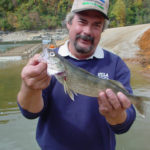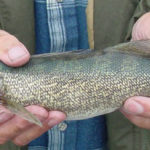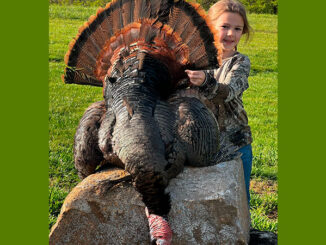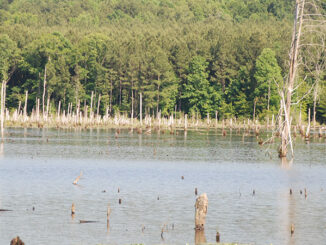
Tasty member of perch family is mountain extra
Walleye are not indigenous to the southern Appalachians, but they have established themselves as a popular gamefish, second only to smallmouth bass.
A northern import, walleye were stocked in mountain reservoirs in the 1950s and are found in many of the larger lakes in North Carolina, from as far west as Hiwassee Lake in Cherokee County to Lake Gaston on the Roanoke River near Roanoke Rapids. In South Carolina, walleye are found in lakes Hartwell and Russell.
Called “pike” by many mountain anglers, walleye are actually part of the perch family, native to the Great Lakes and rivers of the northeastern United States. Long and tubular, walleye are best distinguished by their large, cloudy eyes. Although walleye can grow up to 25 pounds, fish of that size rarely are found in southern Appalachian lakes. Walleye in the 1- to 4-pound range are more common.
The North Carolina state-record walleye, 13.8 pounds, was caught at Lake Chatuge in 1986. South Carolina’s state record, caught at Lake Russell in 1994, is a 10-pounder.
Biologists and avid anglers agree that the best walleye lakes are Fontana Reservoir in Macon and Graham counties, Santeetlah Lake in Graham County, Lake Glenville (aka Thorpe) in Jackson County, Lake James in Burke and McDowell counties, and Hiwassee Lake in Cherokee County.
Jim Mathis, owner of Almond Boat and RV Park on Fontana Lake, said the most-effective method of fishing for walleye is vertical jigging. “How deep they go depends on the water temperature,” he said. “Finding fish at depths of 125 feet is not uncommon. They may be deep, or they may stay in the 70-foot range. There’s no guarantee where they’ll be.”
As for finding walleye, most veteran anglers believe in following the bait. If you see baitfish on your depth finder, walleye will be there; they are fairly consistent in their habits. If you find them at a certain place and at a certain depth one time, chances are good they will be in the same place the next time. Walleye don’t move around much when they find a comfortable place with plenty of food. The secret is to not give up on a spot. Stick it out, and the fish will eventually start feeding again.
Small spoons and jigs are preferred baits. For deep-water jigging, 3/8- and ¾-ounce Cordell spoons work well, also Rapala Ice Jigs: a No. 7 for depths up to 50 feet. For deeper water, a No. 9 Ice Jig gets the lure down more quickly. The lure should match the size of the baitfish. Many walleye fishers tip their ice jigs with a night crawler.
Other effective lures are a 3/8-ounce Hopkins, a 75 Shorty Spoon and a 1-ounce Mann-O-Lure.
Danny Brower of Sylva, who guided walleye and bass fishermen for more than 20 years, said fishing for walleye is similar to fishing for bass with plastic worms. “The presentation has to be slow,” he said. “You have to let them eat the bait.”
Brower used ultralight spinning tackle and 4-pound test line, tying on a 1/8-ounce leadhead jig painted bright red and marked with little black lightning-bolt slashes. He then slid a 2-inch, lime-green or chartreuse grub up the hook to the jighead, pushes the hook through the grub just above the tail, and tipped the hook with a night crawler, hooking the worm near the head and letting the worm dangle.
“If you feel the slightest resistance,” he said, “treat it like a strike. Lower the rod tip, open the bail to let out line, let the fish take the bait, then slowly reel in slack. Set the hook only when you’re sure the fish is on.”
If the line stops falling or moves sideways, that is also a sign of a strike. Often a strike will be little more than a slight thump, because walleye aren’t known as fighting fish. Sometimes, the line may snag on bottom debris or rocks; sometimes the taut line may suddenly go slack when a walleye spits out the bait, but sometimes the slender graphite rod bends almost double with the weight of a 15- or 16-inch walleye, and that makes all the waiting worthwhile.
“They’ll try your patience,” Brower said, “but you have to let them take the bait and not pull it away from them.”
Because walleye have photosensitive eyes, water coloration and light play a key role in successful walleye fishing. The best times to fish for walleye are overcast or cloudy days or at night.
Walleye make spawning runs in early spring, usually between February and March when water temperatures are between 43 and 48 degrees. Most spawning runs occur up major tributaries, but some walleye spawn in lakes, usually around rocky areas.
Fishing in the mountains isn’t always about trout. Walleye can provide a satisfying break from your fishing routine.







Be the first to comment